11. How Airbnb designs for trust / Joe Gebbia
Joe Gebbia, the co-founder of Airbnb, bet his whole company on the belief that people can trust each other enough to stay in one another’s homes. How did he overcome the stranger-danger bias? Through good design. Now, 123 million hosted nights (and counting) later, Gebbia sets out his dream for a culture of sharing in which design helps foster community and connection instead of isolation and separation.
12. Designers, think big! / Tim Brown
Tim Brown says the design profession has a bigger role to play than just creating nifty, fashionable little objects. He calls for a shift to local, collaborative, participatory “design thinking” — starting with the example of 19th-century design thinker Isambard Kingdom Brunel.
13. The best computer interface? Maybe… your hands / James Patten
“The computer is an incredibly powerful means of creative expression,” says designer and TED Fellow James Patten. But right now, we interact with computers, mainly, by typing and tapping. In this nifty talk and demo, Patten imagines a more visceral, physical way to bring your thoughts and ideas to life in the digital world, taking the computer interface off the screen and putting it into your hands.
14. Meet the SixthSense interaction / Pattie Maes
This demo — from Pattie Maes’ lab at MIT, spearheaded by Pranav Mistry — was the buzz of TED. It’s a wearable device with a projector that paves the way for profound interaction with our environment. Imagine “Minority Report” and then some.
15. The 4 superpowers of design / Kevin Bethune
Design veteran Kevin Bethune argues that designers’ talents are often undervalued in business. He says that all designers have four key superpowers: x-ray vision, shapeshifting, extrasensory perception (ESP) and the ability to make others superhuman. Sound unbelievable? Watch and learn what can happen when designers are given space in the workplace to thrive and grow.
16. Why design should include everyone / Sinéad Burke
Sinéad Burke is acutely aware of details that are practically invisible to many of us. At 105 centimeters (or 3′ 5″) tall, the designed world — from the height of a lock to the range of available shoe sizes — often inhibits her ability to do things for herself. Here she tells us what it’s like to navigate the world as a little person and asks: “Who are we not designing for?”
17. Design for all 5 senses / Jinsop Lee
Good design looks great, yes — but why shouldn’t it also feel great, smell great and sound great? Designer Jinsop Lee (a TED Talent Search winner) shares his theory of 5-sense design, with a handy graph and a few examples. His hope: to inspire you to notice great multisensory experiences.
18. The art of first impressions – in design and life / Chip Kidd
Book designer Chip Kidd knows all too well how often we judge things by first appearances. In this hilarious, fast-paced talk, he explains the two techniques designers use to communicate instantly — clarity and mystery — and when, why and how they work. He celebrates beautiful, useful pieces of design, skewers less successful work, and shares the thinking behind some of his own iconic book covers.
19. Design, explained / John Hodgman
Resident expert John Hodgman “explains” the design of three iconic modern objects. Or does he. (From The Design Studio session at TED2012, guest-curated by Chee Pearlman and David Rockwell.)
20. When we design for disability, we all benefit / Elise Roy
“I believe that losing my hearing was one of the greatest gifts I’ve ever received,” says Elise Roy. As a disability rights lawyer and design thinker, she knows that being Deaf gives her a unique way of experiencing and reframing the world — a perspective that could solve some of our largest problems. As she says: “When we design for disability first, you often stumble upon solutions that are better than those when we design for the norm.”
